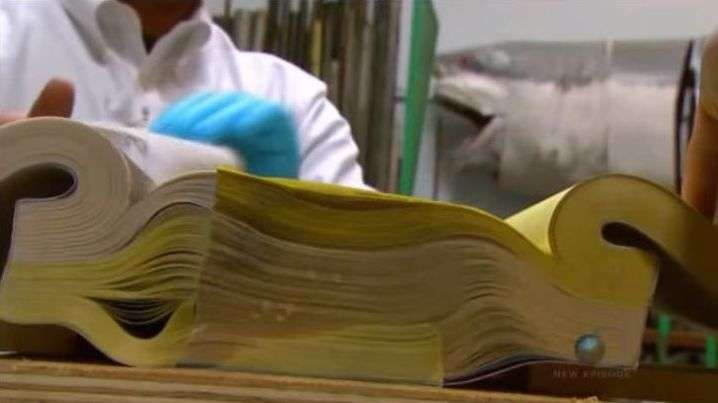December 9, 2015 report
Researchers explain why it's nearly impossible to separate two interleaved phonebooks

(Phys.org)—Many people are familiar with the friction enigma of two interleaved phonebooks, in which all of the pages of two phonebooks are overlapped, one by one, with the books' spines facing outward. Trying to separate the books by pulling on their spines is incredibly difficult due to the massive amount of friction between the pages. A Mythbusters episode showed that the interleaved phonebooks are strong enough to lift a car, and that nothing less than two military tanks can separate them (while tearing many of the pages).
According to a group of scientists who have studied this puzzle, many of the simple explanations of this demonstration are wrong. For instance, one explanation often given is that the weight of the pages pushing down on the pages below them is what generates the large friction force, but this explanation fails to explain why the demonstration works equally as well when carried out in the vertical or horizontal direction.
Now a team of researchers, Héctor Alarcón, et al., from France and Canada have developed a model that reveals how the amount of force required to pull the books apart depends on the number of pages, the page thickness, and the overlapping distance. These relationships were determined by performing dozens of carefully controlled experiments on a vertical pulling device.
This model confirms what has previously been suspected: the harder that a person, car, or tank pulls on the books, the higher the frictional resistance. The researchers compared this "self-induced friction amplification" effect to the Chinese finger trap toy: when you try to pull your finger out of the loosely wrapped braid, the braid tightens around your finger, making it even more difficult to get off.
"The extreme friction of the system is due to the operator," the researchers explained. "The person, car, truck, or tank will amplify the friction arising from a tiny force acting on the outermost pages of the stack that may be no more than the weight of a butterfly."
The scientists explain that this tiny force on the outermost pages originates from the paper's elasticity. The outer pages have a tendency to be flat, so they slightly resist being bowed, and bowing happens because twice as many pages must fit between the books' spines. This friction force starts off small, but the pulling amplifies it exponentially.
More evidence supporting this explanation comes from performing the experiment with two books in which every other page has been removed, so that interleaving results in completely flat pages. These books can be easily pulled apart.
Although the researchers did not specifically investigate methods to separate the phonebooks, their results may offer some insight into efficient separation methods.
"One way may be to blow some air from the sides while gently pulling them apart," coauthor Elie Raphaël at the École Supérieure de Physique et de Chimie Industrielles (ESPCI), Paris, told Phys.org.
The interleaved phonebook demonstration is important because it is just one example of many interleaved assemblies, and these are found in many diverse areas: surgical sutures, adhesive proteins, and the interactions between DNA and viruses all involve friction through interleaving sheets of some sort. Another more familiar example is the way that a sailor can tie a large ship to a dock post simply by wrapping a rope around the post several times. The friction between the loops of rope creates such a strong connection that no ship can pull it loose, and pulling only makes it tighter. The results may also have applications for controlling the friction in micro- and nano- scale mechanical devices.
More information: Héctor Alarcón, et al. "Self-amplification of solid friction in interleaved assemblies." Accepted for publication in Physical Review Letters.
Journal information: Physical Review Letters
© 2015 Phys.org


















